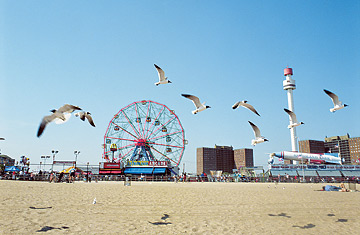
Birds fly over the beach at Coney Island in Brooklyn, NY.
A woman in red satin pants makes her way down the boardwalk on stilts, passing a man shouldering two parrots and a python. It's summertime again at Coney Island, the New York City neighborhood long known for its carnival atmosphere and amusement parks by the sea. This year, though, the mood isn't entirely festive. Uncertainty shrouds the original America's Playground, from the wood-trestled Cyclone roller coaster to the billboard counting down the days until Nathan's annual hot-dog-eating contest. An ambitious real estate developer has bought up two-thirds of Coney Island's main amusement district, and no one is quite sure what will become of it in the fall. "I've been telling everyone to live it up this summer," says Dianna Carlin, who sells T shirts in a pink-walled shop by the beach. "This could be the last season of Coney Island as we know it."
In many ways, that wouldn't be such a bad thing. Coney Island has fallen long and hard from its apex in the early 20th century, when its grandiose rides and spectacles--it once featured a Lilliputian village populated with 300 midgets--were a must-see, even for A-list tourists like Charles Lindbergh and Sigmund Freud, who supposedly declared Coney Island the only part of America that interested him. In the decades that followed, TV and air travel provided other options for escape, as parts of the neighborhood were razed for public housing. Revival-minded artists have partly displaced the crime, drugs and prostitution that took hold in the '60s and '70s, but vacant lots, boarded storefronts and school- bus depots still lap up against Coney Island's main attractions.
Joseph Sitt, the Brooklyn-born developer whose company paid $150 million for 10 acres of central Coney Island, wants to restore the splendor. His plan includes an indoor water park, two hotels and a roller coaster that wraps in and out of buildings. That a large investor has come to the neighborhood is a vindication of the city's strategy to spark private interest by plowing municipal money into improvements such as a minor-league baseball stadium. Coney Island fixture Dick Zigun, who has brought back old traditions like the circus sideshow and invented new ones like the Mermaid Parade, reflects the population's pragmatism: "We went far on spirit alone, but there's only so much you can do without multimillion-dollar investment."
Yet unease is in the air. Sitt has also included a 40-story residential building in his plans. He says amusements aren't profitable on their own, but locals fear that housing in the amusement district would water down Coney Island's noisy eccentricity. The Cyclone and Wonder Wheel are national landmarks, but Sitt's company now plays landlord to most of the rest of Coney Island's rides. The locals are particularly concerned, since some of Sitt's actions-- he demolished go-karts and batting cages this winter, long before he could start building anything to replace them--evoke one of the darker chapters in Coney Island redevelopment. In 1966, Fred Trump (Donald's father) tore down the Steeplechase amusement park to try to prod the city into letting him build high-rise housing. When the city didn't, Trump let the lot lie vacant--until the city bought him out.
But Sitt, who lived within walking distance of Coney Island as a child, insists he'll make the place vibrant again and is even considering ways to build his complex without housing. "This is one of the most important pieces of American history," he says. And his critics seem willing to drop their opposition if he drops housing. "Joe Sitt can still be a hero," says local historian Charles Denson. "He could go down in history as someone who saved Coney Island." But at this point, that's conjecture. The only certain thing is that if you love the old Coney Island, or think you might, now isn't a bad time to swing by Ruby's for a drink with the locals and take a ride to the top of the Astrotower to soak up the raucous glory at your feet.
